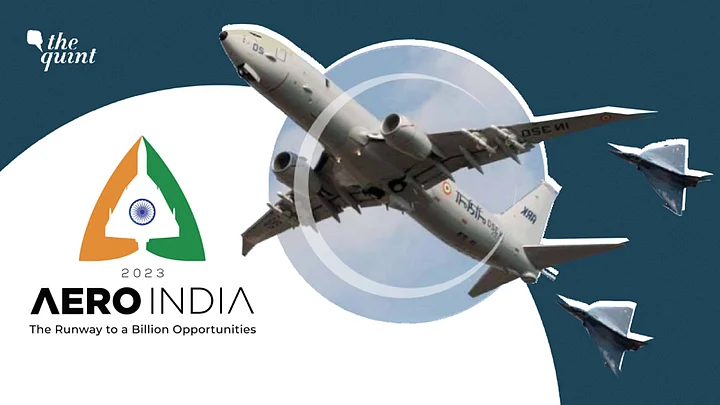The 14th edition of India's biennial air show ‘Aero India‘ was inaugurated by Prime Minister Narendra Modi at Air Force Station Yelahanka, Bengaluru on 13 February.
The business days concluded on 15 February after wide-ranging discussions, signing of MoUs, and seminars attended by officials from defence and industry. A number of delegates and visitors, including serving officials and veterans from the services, trawled through the stalls or availed ‘demo flights’.
The vibrant sentiment around the airshow was 'Make in India' — hard to miss even if no path-breaking deals were signed or announced.
Airshow Opened to Public After the COVID Pandemic
Over 800 exhibitors, including 110 foreign exhibitors, participated in this edition. The five-day event themed ‘the runway to a billion opportunities’ focussed on indigenous aerospace and defence technologies, aligned with the Modi government’s push for ‘Atma Nirbhar Bharat‘ (self-reliant India).
The show was open to public for two days before curtains fell on Friday, 17 February.
Air shows can have a hypnotic effect on soft-nosed delegates and the uninformed. From catching Indian Air Force's ungodly Palam-Bengaluru Aero India shuttle to balancing ‘personal versus professional’, I have been fortunate to witness the travails of military delegates attending the show for about two decades now.
Service personnel deputed from Delhi for the airshow are usually left with a migraine, souvenirs, note sheets, and the tedious task of sifting substance from optics.
A Class Act by HAL’s Rotary Wing
While flying displays, formation aerobatics and the debut of fifth-generation F-35A Lightning II fighters from United States Air Force (USAF) enthralled record crowds, the rotary side of this edition was unmistakably dominated by state-owned defence PSU Hindustan Aeronautics Limited (HAL).
The company’s light helicopter product range — twin-engine Advanced Light Helicopter (ALH, all marks), 3-ton single-engine Light Utility Helicopter (LUH) and the newly-inducted 5.8-ton Light Combat Helicopter (LCH) ‘Prachand’ — dominated the show.
Their flying displays were widely appreciated by the audience, with the LCH ‘Prachand’ coming in for special praise for its menacing looks and remarkable agility. It was a delight to see the LUH that grew up under the threat of ‘exit clause’ for slipping timelines drawing circles of smoke above Yelahanka.
Indigenous Aero Engines Remain a Distant Dream
The Indo-French Ardiden 1H1 ‘Shakti’ turboshaft engine powers the ALH (Mk 3, Mk 4) and LCH while a derated variant Ardiden 1U powers the LUH. A scale model of Indian Multi Role Helicopter (IMRH) was also on display at HAL’s indoor pavilion.
“Safran Helicopter Engines and HAL have signed a workshare agreement for the joint development of the engine intended for the future 13-ton Indian Multi-Role Helicopter and its naval version DBMRH” (deck-based multi role helicopter), HAL tweeted Feb 15. This is in addition to the $716 mn (Rs 5,375 Crore) order for 99 F-404-GE-IN20 engines for Tejas LCA, with more orders to follow for GE-414 engines for future variants.
The entire family of HAL helicopters, expected to total a thousand over five to six variants in near future, will thus be equipped with turboshaft engines from the HAL-Safran joint venture — all customised to meet exacting requirements of ‘hot & high’.
The total number of aero engines that will require to be produced to meet this target may well exceed 2,000. This presents one of the best opportunities for India to negotiate transfer of key aero engine technologies that have eluded us in the past. The Indian government should have leveraged these numbers and our much-vaunted ‘soft power’.
Alas, there is ample evidence this will go down as another “missed opportunity”.
India’s Largest Helicopter Plant Is Here!
The air show was preceded by the inauguration a week before of India’s largest helicopter manufacturing facility on Feb 6. This factory spread over 615 acres has been set up by HAL at Tumakuru, about 70 miles outside Bengaluru, for series production of LUH.
The plant, though under-utilised in the near term, would cater for series production of LUH, LCH and Indian Multi Role Helicopter (IMRH) besides augmenting production and MRO of HAL helicopters. The LUH was unveiled by PM Modi on the occasion even as the first production LUH rolled out of HAL’s Bengaluru plant.
Foreign Competition Climbs Down?
The Indian army and air force have projected a requirement of about 400 light helicopters to replace vintage Alouettes and Lama. An Inter-governmental Agreement (IGA) between New Delhi and Moscow for jointly manufacturing the Ka-226T ‘Climber’ at the plant has not made any progress so far due to workshare differences.
Much has changed since the IGA was inked by PM Modi and President Putin in 2015 (Russia-Ukraine war, Indo-China face-off at LAC and winds of Atma Nirbhar Bharat, to name a few.
Unless
(a) we are interested in gaining expertise over contra-rotating rotor systems & associated transmission for some future rotary program, or
(b) PM Modi wants to dole out favours to President Putin, the Ka-226T project, to my mind, is all but dead.
As I see it, most of the 400 light helicopters, if not all, will come via the LUH route going forward. If HAL capitalises on this windfall, a civil variant of LUH could well dislodge even foreign competitors, something this writer had espoused in an earlier blog.
(The author is an ex-navy experimental test pilot. He is dual ATP-rated on Bell 412 & AW139 helicopters and a synthetic flight instructor on ALH Dhruv. He can be reached on Twitter @realkaypius. Views are personal. This is an opinion piece and the views expressed above are the author’s own. The Quint neither endorses nor is responsible for them.)
(At The Quint, we question everything. Play an active role in shaping our journalism by becoming a member today.)
